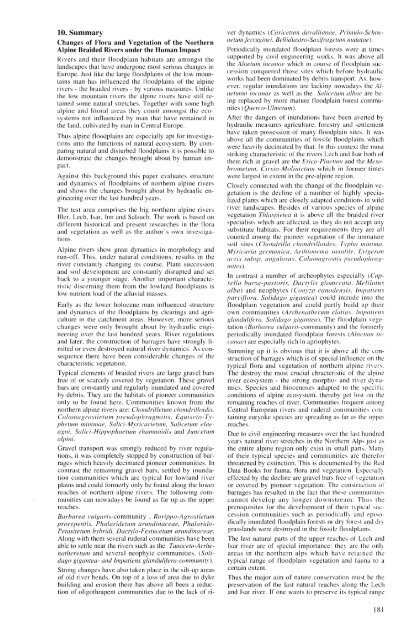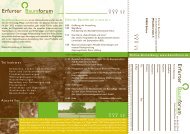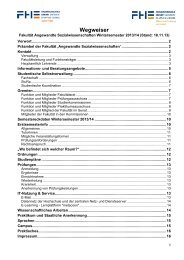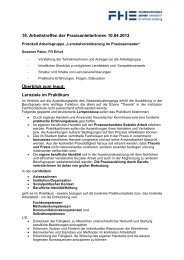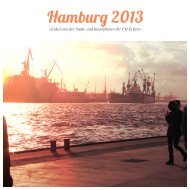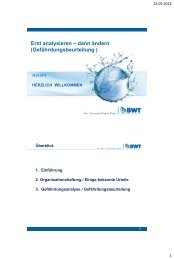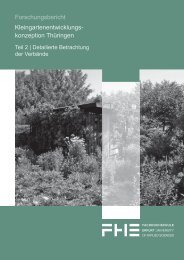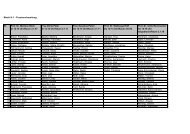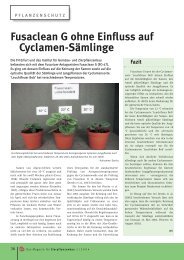Wandel von Flora und Vegetation nordalpiner Wildflußlandschaften ...
Wandel von Flora und Vegetation nordalpiner Wildflußlandschaften ...
Wandel von Flora und Vegetation nordalpiner Wildflußlandschaften ...
Sie wollen auch ein ePaper? Erhöhen Sie die Reichweite Ihrer Titel.
YUMPU macht aus Druck-PDFs automatisch weboptimierte ePaper, die Google liebt.
10. Summary<br />
ver dynainic4 (Ctrr-ic.rrrirrl tltri~trllitrrzrre, Pt-iir~rilo-Schoe-<br />
Changes of <strong>Flora</strong> and <strong>Vegetation</strong> of the Northern<br />
r~etutnfir-I-~igirzoi. Bellitlitr.srtv-Str.~~frfrc~~~~t~t~~~<br />
rrrrittrtcle).<br />
Alpine Braided Rivers <strong>und</strong>er the Human Impact Periodically iniindated floodplain forests were at times<br />
Rivers and their floodplain habitats are amongst the<br />
landscapes that have iindergone most serious changes in<br />
Europe. Just like the large floodplains of the low mountains<br />
man has intluenced the tloodplains of the alpine<br />
rivers - the braided rivers - by various measures. Unlike<br />
the low mountain rivers the alpine rivers have still retained<br />
some natural stretches. Together with some high<br />
alpine and litoral areas they count amongst the ecosystems<br />
not influenced by man that have remained in<br />
supported by civil engineering works. Ii was above all<br />
the Aliler~irn iizctrr7cic whicli in coiirse of floodplain succession<br />
conquered those sites whicli before hydraulic<br />
works had been dominated by debris transport. Ac, however.<br />
regular in<strong>und</strong>ations are lacking nowadays the Al-<br />
~zet~irnri irzctltzcre as well as the Scrlicer~lrn cilbtre are being<br />
replaced by more matiire floodplain forest communites<br />
( Qiit1rc.o-Ult?ieriitn).<br />
After the dangers of in<strong>und</strong>ations have been averted by<br />
the land, cultivated by man in Central Europe.<br />
hydraulic measures agriculture, forestry and settlement<br />
Thus alpine tJoodplains are especially apt for investigations<br />
into the functions of natural ecosystem. By coinparing<br />
natural and disturbed tloodplains it is possible to<br />
demonstrate the changes brought about by human iinpact.<br />
have taken possession OS many floodplain sites. It was<br />
above all the co~iimunities of fossile floodplains which<br />
were heavily decimated by that. In this context the mosi<br />
striking characteristic ol'the rivers Lech and lsar bot11 of<br />
thelii rich in gravel are the Er-jco-Pi17~rr1111 and the Mesobronzetiirrz,<br />
Cir-sio-Molitzict~irn which in former tinies<br />
Against this backgro<strong>und</strong> this paper evaluates structure were largest in extent in the pre-alpine region.<br />
and dynamics OS tloodplains of northern alpine rivers<br />
and shows the changes brought aboui by hydraulic engineering<br />
over the las1 h<strong>und</strong>red years.<br />
Closely connected with the change of the floodplain vegetation<br />
is the decline of a nuinber of highly specialized<br />
plants which are closely adapted conditions in wild<br />
The tesi area co~iiprises the big northern alpine rivers<br />
Iller. Lech, lsar, Inn and Salzach. The work is based on<br />
different historical and present researches in the flora<br />
and vegetation as well as the author's own investigations.<br />
Alpine rivers show greai dynamics in morphology and<br />
run-off. This. iinder natural conditions. results in the<br />
river constantly changing its Course. Plant succession<br />
and soil development are constantly disrupted and set<br />
back to a younger stage. Another importani characteristic<br />
discerning thein from the lowland tloodplains is<br />
low nutrient load of the alluvial masses.<br />
river landscapes. Besides oi various species of alpine<br />
vegetation T11ltr.spi~rt~a it is above all the braided river<br />
specialist5 which are affected. as they do not accept any<br />
substitute habitats. For their requireiiients they are all<br />
counted among the pioneer vegetation OS the immature<br />
soil sites (Chotzdr-illtr c.1zoritir-illoic1c.s. Tjldiri rrziriinirr,<br />
Mj,ric.trrici ger-rn~rriic.cr, Aetl~iorir~tizn .s(l.~(rtilc~, .E/.iger-ori<br />
trcbt.i.s sribsp. c~tzgrr1o.r~c.s. Ccrlrrr17trgr-o.rti.v p.rt~ritlol~lir-cr~qrrzitc2.\<br />
).<br />
In contrast a nu~iiber of archeophytes especially (Ctr17-<br />
.rel1~1 bur-str-pclstoris, Dacpli.~ cqlomrr-trtci, M~lilotri.~<br />
trlhri) and neophytes (Conjccl catltrt1c~t1si.s. 1rlil1trriorl.r<br />
p(~t~'iflor-cl, Solidngo gigclizteci) could iiiti-iide into the<br />
Early as tlie lower holocene man intluenced structure floodplain vegetation and could pai-tly biiild iip their<br />
and dynamics of the tloodplains by clearings and agri- own coinmunities (Ar-I-hrncirl~c~rur?~ ~1trriir.s. lrrll~trriori.r<br />
culture in the catchment areas. However. inore serious glantl~ilif>rrr. Solidtrgo gigtrrzrrtr). The tloodplain Yegechanges<br />
were only brought about by hydraiilic engi- tation (Brirhtrrecl il~ilgrrr-is-community) and the foriiierly<br />
neering over the last h<strong>und</strong>red years. River regulations periodically in<strong>und</strong>ated floodplain forests (Alrlr~rrtrri iiland<br />
later, the construction of barrages have strongly li- c.uriuo) are especially rich in agriophytes.<br />
mited or even destroyed natural river dynamics. As consequence<br />
there have been considerable changes of tlie<br />
characteristic vegetation.<br />
Suliiliiing up it is obvious that it is above all the construction<br />
oi barrages which is of special influence on thr<br />
typical tlora and vegetation of northern alpine ri1c.i-s.<br />
Typical elements of braided rivers are large gravel bars The destroy the most crucial chracteristic of the alpine<br />
free of or scarcely covered by vegetation. These gravel river ecosystem - the strong inorpho- and river d\.nabars<br />
are constantly and regularly in<strong>und</strong>ated and covered inics. Species and biocenoses adapted to the specific<br />
by debris. They are the habitats of pioneer communities conditions of alpine ecosystem, thereby get los[ on tlie<br />
only to be fo<strong>und</strong> here. Communities known from tlie remaining reaches oi river. Communities frequent ainong<br />
northern alpine rivers are: Chorzdrillet~iin choizdrilloidis, Central European rivers and ruderal coinmunitie.\ con-<br />
Crrlnrr~agrostietui?~ l?sc~udophragmiti~~, Eq~iisorn-Ty- taining euryoke species are spreading as far as the Lipper<br />
pI7etunz minirnae, Sci1ic.i-Myric.nrietiirn, Snlicetunz elm- reaches.<br />
ngrzi, Sa1ic.i-Hippo/>h~retuin rhanznoiclis and Juncetuin<br />
nlpiizi.<br />
Due to civil engineering rneasures over the last Ii<strong>und</strong>rrd<br />
years natural river stretches in the Northern Alps jiist ;is<br />
Gravel transport was strongly reduced by river regula- the entire alpine region only exist in sliiall parts. Ma~q<br />
tions, ii was completely stopped by construction of bar- of their typical species and comn~unities ai-e tlieret'or<br />
rages which heavily deciniated pioneer communities. In threatened by extinction. This is documented by the Red<br />
contrast the remaining gravel bars, settled by in<strong>und</strong>a- Data Books for fauna. flora and vegetation. Eipec~all!<br />
tion communities which are typical for lowland river effected by the decline are gravel bars free ol' \,egetation<br />
plains and could foriiierly only be t'o<strong>und</strong> along the lower or covered by pioneer vegetation. The construction ot'<br />
reaches of northern alpine rivers. The following conl- barrages has resulted in the fact that these communities<br />
munities can nowadays be i;l><strong>und</strong> as far up as the upper cannot develop any longer downstream. Thus thr<br />
reaches.<br />
prerequisites for the developinent of their tlpical ~ c -<br />
Barbaren i~~r1~qerri~-commu~iity , Rorippo-Agro~rietur~~ cession cornmunities such as periodicall! and epiwprorepenti~,<br />
Phnlaridetl4in ar~rridincrceae, Phalaritlo- dically in<strong>und</strong>ated floodplain forests or dry t'ore\t and dr!<br />
Petclsitetuin hj,bridi, Dac~lo- Fe~tucetum aruizdinnceae. grasslands were destroyed in the fossile tloodplainh.<br />
Along with them several ruderal communities have been The last natural parts of the upper reaches ot Lech and<br />
able to settle near the rikers such as the Tannceto-Arrhe- lsar river are of special importance: thq are the onl!<br />
nnrllereriiin and several neophyte communities. (Soli- areas in the northern alps which hake retaiiied tlie<br />
dago gigantea- <strong>und</strong> Inzptiriens glanduliferti-commi~nih). typical range of floodplain vegetation and tauna to a<br />
Strong changes have also taken place in the silt-up areas certain extent.<br />
of old river bends. On top of a loss of area due to dyke Thus the major aim of nature conservation iii~i4t be the<br />
building and erosion there has above all been a reduc- preservation of the last natural reaches along the Lech<br />
tion of oligothrapent communities due to the lack of ri- and Isar river. It' one wailts to preserve its typical range


